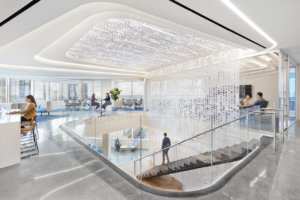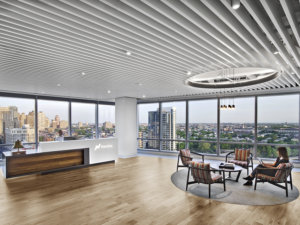Workplace lighting design impacts our health and well-being in a number of ways. Ryan Conover, EDAC, Associate IALD, Associate | Light + Health, and Lillian (Lily) Knoerzer, Associate IALD, Senior Lighting Designer, discuss how workplace lighting affects workers and share some best practices for creating a healthy, productive workplace through lighting design.
Lily and Ryan, when we think of workplace lighting and its impact on human health and well-being, what are some key concepts at play?
Lily: WELL building standards provide a good starting point for everyday best practices in workplace lighting design. Access to daylight is a key factor of feeling healthy at work. We don’t always have a lot of control over this, but architects providing exposure to daylight for users of a space is vitally important in the success of a healthy working environment.
Glare control is another a big concern. Manufacturers are making fixtures increasingly smaller and brighter, which can be uncomfortable for workers, potentially causing issues like eye strain and migraines. It’s important to balance the contrast of electric lighting sources with other surrounding sources of light in a space. For example, as designers we consider how close a user is sitting to a window, the brightness of their monitor, and whether or not there’s a fixture overhead. We evaluate a variety of factors and how they impact each other as we develop a lighting design.
Ryan: Good lighting design is human-centric, and it incorporates light and health. We do that as a baseline. Controllability is a key issue. Having control over your environment, whether it’s workplace or anywhere else, is so important. We no longer design offices with all the lights on at full output, all day long, with no control. We want to create layers of light with lots of controllability and the ability to dim in response to natural light. Daylight harvesting aids in both energy conservation as well as human wellbeing.
Have you developed any other interesting strategies to help promote well-being through lighting?
L: As Ryan mentioned, daylight harvesting is a great strategy, but it’s crucial to review the details thoroughly. For example, when photocells are controlling the light output of a fixture, it’s important to review how exactly fixtures will be dimming in response to daylight so that they don’t appear broken to users in the office.
R: Wayfinding that promotes physical activity is another good practice. We’re all hearing that sitting at your desk all day is as bad as smoking cigarettes. Instead of simply lighting a space with a sea of 2×2’s or linear fixtures, we use wayfinding to encourage users to stay active, even just to get up and get a cup of coffee. We have corporate projects in which we highlighted staircases in a beautiful way to encourage people to skip the elevator and take the stairs.
We are hearing a lot about correlated color temperature (CCT) and circadian lighting. How do CCT and circadian lighting play a role in the workplace?
L: Appropriate color temperatures may help keep users energized and productive. We’ve found that 3500-4000 Kelvin is ideal for offices, as people feel most comfortable working under this range.
Circadian lighting is one of those buzzwords that means different things to different people. I prefer to use WELL standards to define it, which focuses more on the amount of light that users are getting at eye level, as well as the color temperature of the light.
R: Circadian lighting is a strategy that can be used in a corporate environment, but we must be mindful of color temperatures when considering a solution like tunable white systems. Manufacturers are touting tunable white fixtures that mimic daylight and align our circadian rhythms, but we need to consider what it means to work under 6,000 Kelvin in a workplace environment.
Has The Lighting Practice completed any recent projects that used these strategies?
R: We were just hired by a confidential client to analyze their existing corporate headquarters for circadian lighting. They weren’t meeting the criteria for WELL building standards in several areas, so they asked us to survey the site to gain insight and implement solutions with minimal disruption. We found the amount of light at eye level was significantly lower than WELL building standards. Like many offices, their workplace had a very industrial, hospitality-driven feel to it, but sleeker fixtures and cylinder downlights aren’t always the best kit of parts for promoting circadian rhythm. We had to find a solution that maintained the industrial aesthetic of the office while also mitigating cost. It was a really interesting, complex project that’s going into construction now.
Are there any challenges when following these best practices on a project?
L: There are a lot of buzzwords being thrown around and plenty of “quick fixes” on the market, but not all the products being touted by manufacturers have the necessary research to support their use. There are often more complex issues at play. We need to educate our clients and help them understand a better way to hit their goals besides simply buying the latest fixtures.
Finishes can also significantly affect light levels. For example, spaces with dark walls and ceilings can appear gloomy. When designers and clients keep us informed of changes to finishes and materiality, we can ensure the lighting design more successfully serves its purpose and complements the space.
R: Getting in front of the end users is important, as well. We need to educate the client on our recommendations and collect feedback from specific users. For example, an IT department may have different light requirements than a department working on 3D printing. We also consider their current light levels and try to prepare them for any changes based on our recommendations. Ultimately, there is no one-size-fits all solution when it comes to lighting; it’s about understanding all the variables of the architectural design, as well as what will work best for the people in the space.
What are some new technologies and/or trends that are impacting workplace lighting as it relates to human health?
R: Manufacturers are just starting to become more thoughtful and transparent with the components of their fixtures. They’re beginning to eliminate harmful materials, like PVC, in the making of their LED strips. The International Living Future Institute (ILFI) has produced the Red List featuring the worst chemicals prevalent in the building products industry and manufacturers are responding with better quality products.
Products like LED tape light and smaller profile fixtures have been very helpful in creating more comfortable layers of light in a space. These sources can be tucked away into coves to create vertical illumination that feels more natural.
L: If you’re trying to replicate daylight in a space without natural access, fixtures that resemble skylights with indirect, diffuse lighting can make the environment more comfortable. Products like louvers can help mitigate skinny fixtures in a space.






